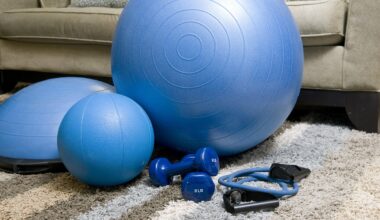Warm-up Strategies to Prevent Injuries During Bodyweight Exercise
Before engaging in bodyweight exercise routines, performing effective warm-up strategies is essential. Warm-ups play a crucial role in preparing your body for physical activities, enhancing performance and preventing injuries. Target the major muscle groups such as the legs, arms, and core to achieve optimal results. Dynamic stretches, like arm circles and leg swings, help improve your range of motion and increase blood flow to the muscles. Additionally, it’s beneficial to perform exercises that mimic the movements you intend to do during your workout. This helps your body adapt and prepares your central nervous system for the ensuing activities. Warm-ups should take about 10 to 15 minutes and can include light cardio to elevate your heart rate gradually. The more prepared you are, the lower the risk of strains, sprains, or other injuries. Incorporating these simple strategies into your routine can provide lasting benefits. Moreover, they can assist in improving your workout performance overall. Make a habit of warming up properly before each session to ensure you’re always in peak condition for your exercises.
There are various effective warm-up exercises specifically designed for bodyweight workouts. Consider starting with high knees, where you jog in place while bringing your knees towards your chest. This exercise boosts heart rate and engages your lower body muscles. Following high knees, incorporate arm crosses; stance firmly, open your arms wide, and cross them in front of your chest. This motion warms up your shoulders effectively. Another essential warm-up is the torso twist, where you stand with feet shoulder-width apart and rotate your torso side to side. This movement activates your core and improves spinal mobility. Incorporating movements like lunges with a twist or squats can further engage your muscles before your intense bodyweight exercises. It’s vital to ensure you maintain a steady, controlled pace throughout your warm-up. Focus on your body’s response to the warming procedures and be mindful of any stiffness or discomfort. Remember, each movement should feel gradual and natural, easing your body into the workout. By performing these various dynamic stretches, you increase your workout effectiveness and reduce injury risks.
Hydration is another critical factor that contributes to the effectiveness of your warm-up routine. It’s vital to stay hydrated before, during, and after your workout sessions to maintain optimal performance levels. Dehydration can lead to muscle fatigue, cramping, and even injuries during bodyweight exercises. Begin your warm-up with a glass of water to ensure your body is primed and ready for the exertion ahead. Consider carrying a water bottle during your workouts to sip as needed. Moreover, monitoring your hydration levels provides added insight into your overall health. Also, be aware of the environment and temperature, as they can impact how much fluid your body needs. On hot days, increased sweating necessitates additional hydration due to fluid loss. Aim for regular hydration habits, and remember that water should be among your primary beverages during exercise. As hydration influences performance and recovery, it’s essential to integrate this practice into your warm-up strategy. Ultimately, proper hydration complements your warm-up, ensuring your body is in the best possible condition for challenging bodyweight exercises.
Breathing Techniques for Warm-ups
In addition to physical movements, effective breathing techniques can significantly impact your warm-up routine. Integrating focused breathing helps enhance oxygen intake, boosting energy levels and preparing your mind for the workout ahead. Ideally, you should practice deep diaphragmatic breathing while performing warm-ups. Inhale deeply through your nose, allowing your diaphragm to expand, and exhale evenly through your mouth. This process fosters relaxation and increases your body’s oxygen supply, improving muscle performance. As you engage in dynamic stretches, synchronize your breath with your movements. For instance, inhale during expansive movements like arm raises, and exhale during contracting motions. This synchronization enhances movement efficiency and promotes better muscle function. Additionally, practicing focused breathing can help you maintain a calm mindset before an intense workout. Mindfulness during warm-up sessions encourages hormonal balance and enables you to focus on specific areas requiring more attention. Incorporating these breathing techniques allows you to foster a deeper connection with your body while preparing for the upcoming bodyweight workouts. Ultimately, effective breathing during warm-ups enhances physical performance and prepares your mind.
Another crucial aspect of warm-up routines is the incorporation of flexibility exercises. While dynamic stretches are essential, adding flexibility work can enhance your overall performance. Flexibility exercises, such as static stretches and foam rolling, assist in increasing blood flow and elongating your muscles. Start by incorporating stretches that target muscle groups you will use during your bodyweight workouts. Focusing on areas like hamstrings, quadriceps, and hip flexors can be particularly beneficial. Hold each stretch for 20–30 seconds without bouncing, allowing your muscles to relax deeply into the movement. Additionally, foam rolling can aid in reducing muscle tension and improving circulation, effectively preparing your body for the demands of exercise. Using a foam roller on major muscle groups, such as your back and thighs, helps release stubborn knots. Incorporate flexibility work into your warm-up routine at least two to three times weekly for optimal results. The more flexible you become, the better you’ll perform during bodyweight exercises. Remember that flexibility is vital not only for performance but also for avoiding injuries during workouts.
Pacing Your Warm-up
Pacing is an essential strategy when developing your warm-up routines for bodyweight exercises. Gradually increasing your intensity during the warm-up phase helps optimize performance while minimizing injury risks. Consider starting with low-intensity movements, such as light jogging or marching in place, before progressing to higher intensity dynamic stretches. This gradual increase allows your muscles to adjust and prepare for upcoming tasks. Moreover, avoiding abrupt changes in intensity helps promote blood flow, thereby enhancing muscle elasticity. Listen to your body during warm-ups; if you feel overly fatigued or experience discomfort, slow down the pace. Additionally, allocating sufficient time for your warm-up can yield significant benefits. Ideally, plan for a warm-up duration of 10 to 15 minutes, tailored to your needs. The key is to ensure you are adequately warmed up and ready for your bodyweight workout. Finally, always ensure that your body is fully engaged before moving to intense exercise. A well-paced warm-up is crucial for promoting safety and effectiveness throughout your exercise routines.
In summary, effective warm-up strategies are indispensable for bodyweight exercise routines. Understanding the importance of warming up, including various physical techniques, hydration, breathing methods, flexibility work, and pacing, ensures optimal performance and injury prevention. By dedicating time to properly prepare your body for physical exertion, you increase your chances of enjoying a successful workout. Always remember to listen to your body’s signals, adjusting your warm-up intensity and duration according to your fitness levels. By incorporating these valuable strategies, you can enhance the effectiveness of your workouts and ensure a safer exercise experience. Moreover, instilling a consistent warm-up routine fosters a deeper connection between mental focus and physical readiness. Make warming up an integral part of your fitness regimen, as it significantly impacts both performance and recuperation. Through careful planning and execution, you’re paving the way for successful bodyweight exercises and long-term fitness goals. Ultimately, achieving your desired results requires commitment, consistency, and a dedication to prioritizing a solid warm-up strategy for all your workouts.
Remember to adjust your warm-up routine based on your fitness level. Beginners should focus primarily on learning the basic warm-up techniques and movements at a comfortable pace until they gain more experience. As proficiency develops, they may gradually increase the complexity and intensity of their warm-ups. For those more advanced, warm-up strategies may include additional functional movements or sport-specific drills. Tailoring these warm-ups to individual needs ensures each session effectively prepares the body. As you incorporate these strategies into your routine, maintaining good form is essential. Your breathing, control, and posture during warm-ups influence how well your body transitions into exercise. Regularly evaluating how you feel during warm-ups can improve your routine over time. Don’t hesitate to change things if specific strategies don’t align with your body’s needs. Embrace flexibility in your approach, ensuring it remains enjoyable while safeguarding against injuries. By fostering a habit of consistency and mindful presence, your body will grow stronger and more resilient. Ultimately, a good warm-up establishes a solid foundation, enabling you to tackle bodyweight exercises with confidence and passion for your fitness journey.


